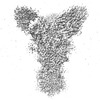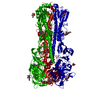[English] 日本語
 Yorodumi
Yorodumi- EMDB-26202: Cryo-EM structure of antibody TJ5-5 bound to H3 COBRA TJ5 hemaggl... -
+ Open data
Open data
- Basic information
Basic information
| Entry |  | |||||||||
|---|---|---|---|---|---|---|---|---|---|---|
| Title | Cryo-EM structure of antibody TJ5-5 bound to H3 COBRA TJ5 hemagglutinin | |||||||||
 Map data Map data | COBRA TJ5 complexed with monoclonal antibody TJ5-5 | |||||||||
 Sample Sample |
| |||||||||
 Keywords Keywords | H3 influenza virus / monoclonal antibody / VIRAL PROTEIN-IMMUNE SYSTEM complex | |||||||||
| Function / homology |  Function and homology information Function and homology informationviral budding from plasma membrane / clathrin-dependent endocytosis of virus by host cell / host cell surface receptor binding / apical plasma membrane / fusion of virus membrane with host plasma membrane / fusion of virus membrane with host endosome membrane / viral envelope / virion attachment to host cell / host cell plasma membrane / virion membrane Similarity search - Function | |||||||||
| Biological species |  Homo sapiens (human) / Homo sapiens (human) /   unidentified influenza virus / unidentified influenza virus /   Influenza A virus Influenza A virus | |||||||||
| Method | single particle reconstruction / cryo EM / Resolution: 3.41 Å | |||||||||
 Authors Authors | Abbadi NS / Mousa JJ | |||||||||
| Funding support |  United States, 1 items United States, 1 items
| |||||||||
 Citation Citation |  Journal: J Virol / Year: 2022 Journal: J Virol / Year: 2022Title: Differential Recognition of Computationally Optimized H3 Hemagglutinin Influenza Vaccine Candidates by Human Antibodies. Authors: Nada Abbadi / Kaito Nagashima / Alma Pena-Briseno / Ted M Ross / Jarrod J Mousa /  Abstract: Among circulating influenza viruses in humans, H3N2 viruses typically evolve faster than other subtypes and have caused disease in millions of people since emerging in 1968. Computationally optimized ...Among circulating influenza viruses in humans, H3N2 viruses typically evolve faster than other subtypes and have caused disease in millions of people since emerging in 1968. Computationally optimized broadly reactive antigen (COBRA) technology is one strategy to broaden vaccine-elicited antibody responses among influenza subtypes. In this study, we determined the structural integrity of an H3N2 COBRA hemagglutinin (HA), TJ5, and we probed the antigenic profile of several H3N2 COBRA HAs by assessing recognition of these immunogens by human B cells from seasonally vaccinated human subjects. Of three recently described COBRA H3 HA antigens (TJ5, NG2, and J4), we determined that TJ5 and J4 HA proteins recognize pre-existing B cells more effectively than NG2 HA and a wild-type Hong Kong/4801/2014 protein. We also isolated a panel of 12 H3 HA-specific human monoclonal antibodies (MAbs) and identified that most MAbs recognize both wild-type and COBRA HA proteins and have functional activity against a broad panel of H3N2 viruses. Most MAbs target the receptor-binding site, and one MAb targets the HA stem. MAb TJ5-5 recognizes TJ5 and J4 COBRA HA proteins but has poor recognition of NG2 HA, similar to the global B-cell analysis. We determined a 3.4 Å structure via cryo-electron microscopy of Fab TJ5-5 complexed with the H3 COBRA TJ5, which revealed residues important to the differential binding. Overall, these studies determined that COBRA H3 HA proteins have correct antigenic and structural features, and the proteins are recognized by B cells and MAbs isolated from seasonally vaccinated humans. Vaccine development for circulating influenza viruses, particularly for the H3N2 subtype, remains challenging due to consistent antigenic drift. Computationally optimized broadly reactive antigen (COBRA) technology has proven effective for broadening influenza hemagglutinin (HA)-elicited antibody responses compared to wild-type immunogens. Here, we determined the structural features and antigenic profiles of H3 COBRA HA proteins. Two H3 COBRA HA proteins, TJ5 and J4, are better recognized by pre-existing B cells and monoclonal antibodies from the 2017 to 2018 vaccine season compared to COBRA NG2 and a wild-type A/Hong Kong/2014 HA protein. We determined a cryo-electron microscopy (cryo-EM) structure of one MAb that poorly recognizes NG2, MAb TJ5-5, in complex with the TJ5 COBRA HA protein and identified residues critical to MAb recognition. As NG2 is more effective than TJ5 for the recent Hong Kong/2019 virus, these data provide insights into the diminished effectiveness of influenza vaccines across vaccine seasons. | |||||||||
| History |
|
- Structure visualization
Structure visualization
| Supplemental images |
|---|
- Downloads & links
Downloads & links
-EMDB archive
| Map data |  emd_26202.map.gz emd_26202.map.gz | 259.8 MB |  EMDB map data format EMDB map data format | |
|---|---|---|---|---|
| Header (meta data) |  emd-26202-v30.xml emd-26202-v30.xml emd-26202.xml emd-26202.xml | 12.9 KB 12.9 KB | Display Display |  EMDB header EMDB header |
| Images |  emd_26202.png emd_26202.png | 127.9 KB | ||
| Filedesc metadata |  emd-26202.cif.gz emd-26202.cif.gz | 5.6 KB | ||
| Archive directory |  http://ftp.pdbj.org/pub/emdb/structures/EMD-26202 http://ftp.pdbj.org/pub/emdb/structures/EMD-26202 ftp://ftp.pdbj.org/pub/emdb/structures/EMD-26202 ftp://ftp.pdbj.org/pub/emdb/structures/EMD-26202 | HTTPS FTP |
-Validation report
| Summary document |  emd_26202_validation.pdf.gz emd_26202_validation.pdf.gz | 546.1 KB | Display |  EMDB validaton report EMDB validaton report |
|---|---|---|---|---|
| Full document |  emd_26202_full_validation.pdf.gz emd_26202_full_validation.pdf.gz | 545.7 KB | Display | |
| Data in XML |  emd_26202_validation.xml.gz emd_26202_validation.xml.gz | 8.2 KB | Display | |
| Data in CIF |  emd_26202_validation.cif.gz emd_26202_validation.cif.gz | 9.5 KB | Display | |
| Arichive directory |  https://ftp.pdbj.org/pub/emdb/validation_reports/EMD-26202 https://ftp.pdbj.org/pub/emdb/validation_reports/EMD-26202 ftp://ftp.pdbj.org/pub/emdb/validation_reports/EMD-26202 ftp://ftp.pdbj.org/pub/emdb/validation_reports/EMD-26202 | HTTPS FTP |
-Related structure data
| Related structure data |  7tz5MC M: atomic model generated by this map C: citing same article ( |
|---|---|
| Similar structure data | Similarity search - Function & homology  F&H Search F&H Search |
- Links
Links
| EMDB pages |  EMDB (EBI/PDBe) / EMDB (EBI/PDBe) /  EMDataResource EMDataResource |
|---|---|
| Related items in Molecule of the Month |
- Map
Map
| File |  Download / File: emd_26202.map.gz / Format: CCP4 / Size: 512 MB / Type: IMAGE STORED AS FLOATING POINT NUMBER (4 BYTES) Download / File: emd_26202.map.gz / Format: CCP4 / Size: 512 MB / Type: IMAGE STORED AS FLOATING POINT NUMBER (4 BYTES) | ||||||||||||||||||||||||||||||||||||
|---|---|---|---|---|---|---|---|---|---|---|---|---|---|---|---|---|---|---|---|---|---|---|---|---|---|---|---|---|---|---|---|---|---|---|---|---|---|
| Annotation | COBRA TJ5 complexed with monoclonal antibody TJ5-5 | ||||||||||||||||||||||||||||||||||||
| Projections & slices | Image control
Images are generated by Spider. | ||||||||||||||||||||||||||||||||||||
| Voxel size | X=Y=Z: 0.526 Å | ||||||||||||||||||||||||||||||||||||
| Density |
| ||||||||||||||||||||||||||||||||||||
| Symmetry | Space group: 1 | ||||||||||||||||||||||||||||||||||||
| Details | EMDB XML:
|
-Supplemental data
- Sample components
Sample components
-Entire : H3 COBRA HA protein in complex with human antibody TJ5-5
| Entire | Name: H3 COBRA HA protein in complex with human antibody TJ5-5 |
|---|---|
| Components |
|
-Supramolecule #1: H3 COBRA HA protein in complex with human antibody TJ5-5
| Supramolecule | Name: H3 COBRA HA protein in complex with human antibody TJ5-5 type: complex / ID: 1 / Parent: 0 / Macromolecule list: all |
|---|---|
| Source (natural) | Organism:  Homo sapiens (human) Homo sapiens (human) |
-Supramolecule #2: H3 COBRA hemagglutinin protein
| Supramolecule | Name: H3 COBRA hemagglutinin protein / type: complex / ID: 2 / Parent: 1 / Macromolecule list: #3 |
|---|---|
| Source (natural) | Organism:   unidentified influenza virus unidentified influenza virus |
-Supramolecule #3: Human antibody TJ5-5
| Supramolecule | Name: Human antibody TJ5-5 / type: complex / ID: 3 / Parent: 1 / Macromolecule list: #1-#2 |
|---|---|
| Source (natural) | Organism:  Homo sapiens (human) Homo sapiens (human) |
-Macromolecule #1: TJ5-5 heavy chain
| Macromolecule | Name: TJ5-5 heavy chain / type: protein_or_peptide / ID: 1 / Number of copies: 3 / Enantiomer: LEVO |
|---|---|
| Source (natural) | Organism:  Homo sapiens (human) Homo sapiens (human) |
| Molecular weight | Theoretical: 13.487161 KDa |
| Recombinant expression | Organism:  Homo sapiens (human) Homo sapiens (human) |
| Sequence | String: VQLVQSGAEV KKPGSSVKVS CKASGVTFTY YTISWVRQAP GQGLEWMGGI MPMFGTPNYA QKFQGRVTIT ADEPTSTIYM MLSSLRSED TAVYYCASLG NYESGGYHPY FEYWGHGTLV TVSS |
-Macromolecule #2: TJ5-5 light chain
| Macromolecule | Name: TJ5-5 light chain / type: protein_or_peptide / ID: 2 / Number of copies: 3 / Enantiomer: LEVO |
|---|---|
| Source (natural) | Organism:  Homo sapiens (human) Homo sapiens (human) |
| Molecular weight | Theoretical: 11.114028 KDa |
| Recombinant expression | Organism:  Homo sapiens (human) Homo sapiens (human) |
| Sequence | String: SVLTQPPSVS GAPGQRVTIS CTGSSSNIGA GYDVHWYQQL PGTAPRLLIY GNSNRPSGVP DRFSGSRSGT SASLAITGLQ AEDEADYYC QSYDNSLSGS GVFGGGTKL |
-Macromolecule #3: Hemagglutinin
| Macromolecule | Name: Hemagglutinin / type: protein_or_peptide / ID: 3 / Number of copies: 3 / Enantiomer: LEVO |
|---|---|
| Source (natural) | Organism:   Influenza A virus Influenza A virus |
| Molecular weight | Theoretical: 55.677242 KDa |
| Recombinant expression | Organism:  Homo sapiens (human) Homo sapiens (human) |
| Sequence | String: NSTATLCLGH HAVPNGTIVK TITNDQIEVT NATELVQSSS TGEICDSPHQ ILDGENCTLI DALLGDPQCD GFQNKKWDLF VERSKAYSN CYPYDVPDYA SLRSLVASSG TLEFNNESFN WTGVTQNGTS SACIRRSNNS FFSRLNWLTH LNFKYPALNV T MPNNEQFD ...String: NSTATLCLGH HAVPNGTIVK TITNDQIEVT NATELVQSSS TGEICDSPHQ ILDGENCTLI DALLGDPQCD GFQNKKWDLF VERSKAYSN CYPYDVPDYA SLRSLVASSG TLEFNNESFN WTGVTQNGTS SACIRRSNNS FFSRLNWLTH LNFKYPALNV T MPNNEQFD KLYIWGVHHP GTDKDQIFLY AQASGRITVS TKRSQQAVIP NIGSRPRVRN IPSRISIYWT IVKPGDILLI NS TGNLIAP RGYFKIRSGK SSIMRSDAPI GKCNSECITP NGSIPNDKPF QNVNRITYGA CPRYVKQSTL KLATGMRNVP EKQ TRGIFG AIAGFIENGW EGMVDGWYGF RHQNSEGRGQ AADLKSTQAA IDQINGKLNR LIGKTNEKFH QIEKEFSEVE GRIQ DLEKY VEDTKIDLWS YNAELLVALE NQHTIDLTDS EMNKLFEKTK KQLRENAEDM GNGCFKIYHK CDNACIGSIR NGTYD HDVY RDEALNNRFQ I UniProtKB: Hemagglutinin |
-Experimental details
-Structure determination
| Method | cryo EM |
|---|---|
 Processing Processing | single particle reconstruction |
| Aggregation state | particle |
- Sample preparation
Sample preparation
| Buffer | pH: 7.5 |
|---|---|
| Vitrification | Cryogen name: ETHANE |
- Electron microscopy
Electron microscopy
| Microscope | TFS GLACIOS |
|---|---|
| Image recording | Film or detector model: FEI FALCON IV (4k x 4k) / Average electron dose: 57.22 e/Å2 |
| Electron beam | Acceleration voltage: 200 kV / Electron source:  FIELD EMISSION GUN FIELD EMISSION GUN |
| Electron optics | Illumination mode: FLOOD BEAM / Imaging mode: BRIGHT FIELD / Nominal defocus max: 2.0 µm / Nominal defocus min: 0.9 µm |
- Image processing
Image processing
| Startup model | Type of model: PDB ENTRY PDB model - PDB ID: |
|---|---|
| Final reconstruction | Resolution.type: BY AUTHOR / Resolution: 3.41 Å / Resolution method: FSC 0.143 CUT-OFF / Number images used: 101267 |
| Initial angle assignment | Type: NOT APPLICABLE |
| Final angle assignment | Type: NOT APPLICABLE |
 Movie
Movie Controller
Controller









 Z (Sec.)
Z (Sec.) Y (Row.)
Y (Row.) X (Col.)
X (Col.)





















